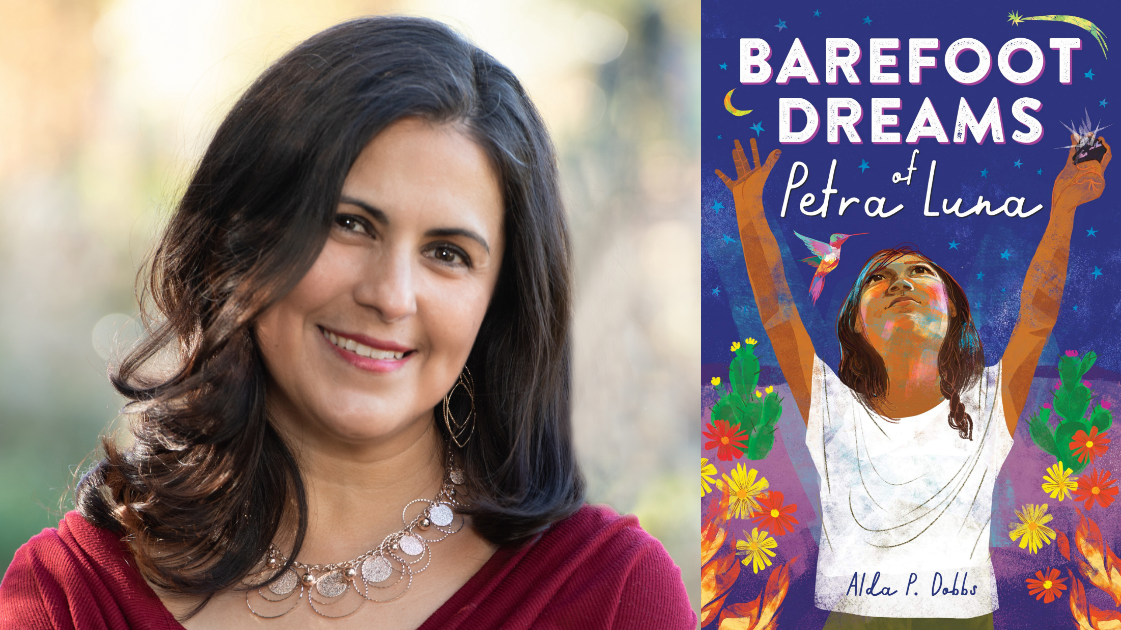Barefoot Dreams of Petra Luna
Alda P. Dobbs
|
In Barefoot Dreams of Petra Luna, 12-year-old protagonist Petra Luna hopes for the most fundamental basics many 12-year-old children should be guaranteed—safety and peace for her family, access to food, and the opportunity to learn to read and write. But when Petra’s dreams are thwarted because of the Mexican War waging between the Federales and the Revolutionaries, Petra’s basic needs are no longer guaranteed. As with any war story, this story bears witness to the way children—the most innocent victims of war—are forced to act like adults during wartime. After Petra’s father chooses the firing squad before fighting with the Federales, Petra is the one who changes her father’s fate. Running in front of her papa as he stands blindfolded in front of the firing squad, her father promises to join the Federales in their war rather than be killed in front of Petra. In exchange for his promise, Petra makes a promise to take care of her siblings and grandmother. When Petra’s father leaves to fight in the war, Petra becomes the head of her household at age 12, working to chop and sell firewood to buy food for her family. Eventually—as is common in wartime—Petra’s family is displaced when their home is no longer safe, and as they travel north towards the Mexico-United States border where Petra believes she and her small family might find safety, the journey forces Petra to navigate their challenges using adult-like skills. |
Barefoot Dreams of Petra Luna not only bears witness to the child caught in wartime, but it also bears witness to the stories of war leaders whose leadership has not often been documented in our history books, especially when those war leaders are women. As Petra leads her family on their journey north to the Mexico-United States border, she encounters help along the way from many women who are serving for the Revolutionaries in the war. Petra meets Marietta, a soldadera referred to as La Capitana, whose career fighting for the Revolutionaries began disguised as a man. Petra also meets Doña Amparo, a widowed woman who calls herself “a madre” and “make[s] a living by cooking and cleaning for soldiers who have no family” (p. 152). According to a third female character named Luz, both Luz and Doña Amparo are referred to as “camp follower[s],” but Luz asserts that they serve as “the backbone of [the] revolution” (p. 152.) Not only does this story highlight a strong female protagonist in Petra Luna, but the novel also recovers the stories of multiple women whose resilience and integrity during wartime exhibit leadership behavior that helps develop a Mexican cultural sensibility.
Even while this story is mostly set in Mexico, it is not solely a Mexican story. This story is a borderlands story, telling a history about the people (and their antepasados) who inhabit the third space situated between Mexico and the United States. This story is about how Mexicans came to live in that third space and who they brought with them and how their cultural pride survived out of love for their country, their families, and their values. To read about Petra Luna’s journey—which highlights the trauma children are forced to face in war and which recovers war stories much more complex than the male-driven narratives history books often share—is to better understand the challenges Mexicans have sought to escape by journeying to the United States. For Mexican American children, this book provides an important facet of history often overlooked, ignored, or erased in their United States education. Centering a humanistic understanding of the Mexico United States immigration story in a middle-grade novel allows children in the United States to empathize with their Mexican American peers while tasting a bit of the rich history and fortitude of the Mexican culture.
Even while this story is mostly set in Mexico, it is not solely a Mexican story. This story is a borderlands story, telling a history about the people (and their antepasados) who inhabit the third space situated between Mexico and the United States. This story is about how Mexicans came to live in that third space and who they brought with them and how their cultural pride survived out of love for their country, their families, and their values. To read about Petra Luna’s journey—which highlights the trauma children are forced to face in war and which recovers war stories much more complex than the male-driven narratives history books often share—is to better understand the challenges Mexicans have sought to escape by journeying to the United States. For Mexican American children, this book provides an important facet of history often overlooked, ignored, or erased in their United States education. Centering a humanistic understanding of the Mexico United States immigration story in a middle-grade novel allows children in the United States to empathize with their Mexican American peers while tasting a bit of the rich history and fortitude of the Mexican culture.
Alda P. Dobbs is the author of the novel Barefoot Dreams of Petra Luna. She was born in a small town in northern Mexico but moved to San Antonio, Texas as a child. Alda studied physics and worked as an engineer before pursuing her love of storytelling. She’s as passionate about connecting children to their past, their communities, different cultures and nature as she is about writing.
Barefoot Dreams of Petra Luna is a publication by Sourcebooks Young Readers. Click here to purchase.
Barefoot Dreams of Petra Luna is a publication by Sourcebooks Young Readers. Click here to purchase.
Comment Box is loading comments...
|
|









